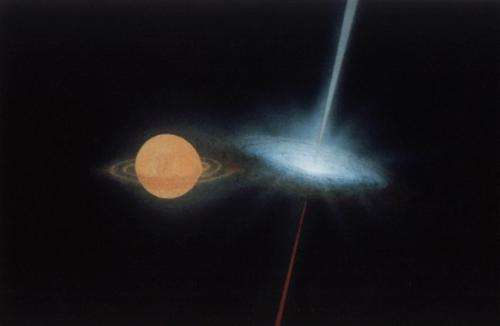Black hole jets

(PhysOrg.com) -- Black holes are irresistible sinks for matter and energy. They are so dense that not even light can escape from their gravitational clutches. Massive black holes (equal to millions or even billions of solar masses) develop during collisions between galaxies. More ordinary, stellar-mass-sized black holes form as remnants of the explosive deaths of stars, and are thought to contain not more than about twenty solar masses of material.
Astronomers study black holes not only because they are bizarre. They are also fundamental to our understanding of gravity and to the evolutionary cycle of stars and galaxies. Observational research is possible because, despite their reputation for being pitiless devourers of matter and energy, black holes are often sources of powerful radiation, for the following reason. When the black hole has a companion star orbiting it, matter from the companion can form a disk of material close to the black hole. These disks often radiate brightly from the heat of friction. Moreover, clumps of material from the companion star, if they fall onto the disk, can result in the occasional ejection of powerful jets of charged particles, sometimes at speeds approaching that of light.
What actually powers these jets has been a mystery. Astronomers and physicists have known that a black hole that spins could in principle produce a jet, but a mechanism for doing so has been a puzzle. Some scientists have suggested that magnetic fields in the vicinity of an accreting, rotating black hole could become twisted, enabling them to carry away energy as an electromagnetic jet, but there has been no direct observational evidence for such a link. Until now.
CfA astronomers Ramesh Narayan and Jeffrey McClintock have been able to estimate the spin of a black hole using models for the X-rays that are emitted. They made such estimates for four black hole binaries. Then they examined the strength of the radio continuum emission from these objects, emission that is a measure of the jet activity. The four objects span a wide range of spins and jet powers. They find for the first time convincing, direct evidence that the jet power scales with the black hole spin, consistent with (though not proof of) the idea that the jets are driven directly by the spin energy of an accreting black hole.
Provided by Harvard-Smithsonian Center for Astrophysics




















